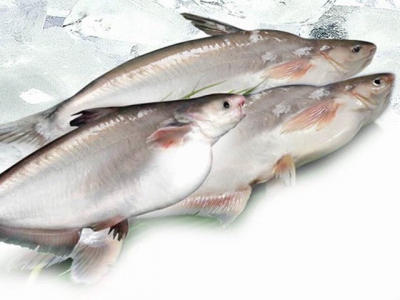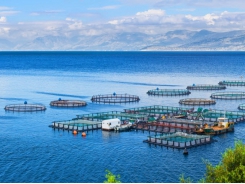Reducing Catfish Feed Cost - Part 1

The Mississippi Agricultural and Forestry Experiment Station (MAFES) and Delta Western Research Centre (DWRC) have collaborated on catfish nutrition research for two decades with the primary goal of reducing catfish production cost by developing cost-efficient feeds and by improving feeding strategies.
Introduction
This work, summarised in MAFES Bulletin 1144 (Robinson and Li 2005), provides nutritional information that can significantly reduce the cost of commercial catfish feeds. Specifically, a part of this research showed that properly balanced low-protein diets have potential for use in catfish production, (Robinson and Li 1997, 2005, 2007; Li et al. 2000, 2001, 2003a, 2003b; Robinson et al. 2001).
In addition, it may be possible to replace a major portion of soybean meal in catfish diets with less expensive feedstuffs (Robinson and Li 1993, 1994, 1999a, 1999b, 1999c, 2005; Li and Robinson 2006) or part of the corn with other less expensive energy feedstuffs (Robinson and Li 2005). Also, research on feeding catfish using high-protein finishing feeds to improve body composition and reduce feed cost has been conducted (Robinson and Jackson 1991; Robinson 1994).
Given recent increases in the price of commercial catfish feeds, additional research on reducing feed cost is warranted. The data presented in this bulletin were derived from three studies conducted over two years to further evaluate three areas: (1) low-protein, cottonseed-meal (CSM), gluten-based (corn gluten feed) diets; (2) low-corn diets; and (3) finishing diets.
Methods
General
The Delta Western Research Center (DWRC) in Indianola, Mississippi, manufactured experimental diets as extruded floating pellets. DWRC manufactured fresh lots of each feed as needed. All dietary ingredients were obtained from the DWRC and were from commercial sources. All diets were formulated to meet or exceed the dietary requirements for channel catfish, with the exception of diets that were specifically formulated to contain less protein than normally considered adequate for channel catfish (NRC 1993; Robinson et al. 2001).
Fingerling channel catfish averaging 67–220 pounds per 1,000 (size varied among studies) were stocked into 0.1-acre ponds at a density of 6,000 fish per acre at DWRC. Five ponds were allotted to each dietary treatment in a complete randomized design. Fish were fed once daily to apparent satiation from mid-April to mid-October for one or two growing seasons, depending on the specific study. During the growing season, water temperature and dissolved oxygen were measured in early morning, mid-afternoon, and throughout the night. Emergency aeration was provided when dissolved oxygen levels decreased to 4 ppm.
Total ammonia-nitrogen (TAN), nitrite-nitrogen (NO2-N), and pH were measured weekly during the growing season. Water quality was maintained in ranges considered adequate for optimum fish performance (Tucker and Robinson 1990). Dead fish were removed from ponds, weighed, and recorded for correction of feed conversion ratio (FCR) at the end of the study.
Fish that were fed for two growing seasons were overwintered in their respective ponds and fed the appropriate experimental diets once or twice weekly when water temperatures exceeded 55oF.

At the end of Studies 1 and 3, 30 fish from each pond were selected for subsequent processing to determine dressed yield. Fillets (one fillet per fish, 10 fish per pond) were stored at -40F for subsequent proximate analyses. After sampling, all fish from each pond were harvested, counted, and weighed. Data collected included weight gain, feed conversion ratio, survival, dressed yield, and fillet proximate composition (AOAC 2000). All data were subjected to ANOVA and the Fisher’s protected LSD procedure (Steel et al. 1997) using Statistical Analysis System version 8.0 software (SAS Institute, Inc., Cary, North Carolina, USA).

Specific Studies
Study 1: Low-protein, cottonseed-meal, and gluten-based diets — Six dietary treatments ranging from 18 per cent to 28 per cent protein with 2 per cent increments in protein between each dietary level (Table 1) were fed daily to channel catfish (initial weight = 142 pounds per 1,000 fingerlings) for two growing seasons.
Study 2: Low-corn diets — Four dietary treatments containing 0 per cent, 7.5 per cent, 15 per cent, or 25 per cent corn grain (Table 2) were fed daily to channel catfish (initial weight = 67 pounds per 1,000 fingerlings) for two growing seasons.
Study 3: Finishing diets — The following eight dietary treatments were fed to channel catfish (initial weight = 220 pounds per 1,000 fingerlings) daily for one growing season: (1) 32 per cent protein diet throughout; (2) 28 per cent protein diet throughout; (3) 24 per cent protein diet throughout; (4) 24 per cent protein diet for 60 days, and then 32 per cent protein diet for 120 days; (5) 24 per cent protein diet for 90 days, and then 32 per cent protein diet for 90 days; (6) 24 per cent protein diet for 120 days, and then 32 per cent protein diet for 60 days; (7) 24 per cent protein diet for 90 days, and then 28 per cent protein diet for 90 days; and (8) 28 per cent protein for 90 days, and then 32 per cent diet for 90 days. Commercial catfish feeds, manufactured by Delta Western Feed Mill of Indianola, Mississippi, were used in this study.
Results
Study 1: Low-Protein, CSM, and Gluten-Based Diets
Based on regression analysis, there was a significant increase in weight gain and decrease in feed conversion as dietary protein increased (Table 3). Examining individual treatment means, weight gain of fish fed diets containing 18 per cent or 20 per cent protein was significantly lower than weight gains of fish fed diets containing 26 per cent or 28 per cent protein.
There were no statistical differences in weight gain of fish fed diets containing 22–28 per cent protein. Feed conversion was statistically the same for fish fed 20–28 per cent protein diets. There were no statistical differences in percentage survival among fish fed the different diets.
Regression analysis showed a significant increase in both carcass and fillet yield as dietary protein increased (Table 4). Individual means of carcass and fillet yield were highest in fish fed 26 per cent or 28 per cent protein diets. Nugget yield was unaffected by dietary protein. As dietary protein levels increased, fillet protein and moisture generally increased and fillet fat decreased (Table 5).



Study 2: Low-Corn Diets
Feed consumption was higher in fish fed diets containing 0 per cent or 7.5 per cent corn grain than for fish fed diets containing higher levels of corn grain (Table 6). Weigh gain was not significantly different among diets. Feed conversion was significantly lower for fish fed diets containing 15 per cent or 25 per cent corn grain, compared with those fed diets containing lower levels of corn grain. Fish fed the diet containing no corn grain had the highest feed conversion.
Study 3: Finishing Diets
There were no significant differences in weight gain among fish on the various treatments except for a reduction in weight gain in fish fed the 24 per cent protein diet throughout the growing season (Table 7).
The fish on this treatment consumed less feed and had a higher feed conversion than fish on other treatments. Fish fed the 28 per cent protein diet throughout the growing season had a significantly lower feed conversion than fish fed the 24 per cent or 32 per cent protein diet for the entire growing season or fish fed the 24 per cent protein diet for 120 days and then the 32 per cent protein diet for 60 days. However, it was not different from the feed conversion of fish on other treatments. Survival was not different among treatments.
Carcass yield was not significantly affected by dietary treatment (Table 8). Fillet yield was slightly lower for fish fed the 24 per cent protein diet throughout the growing season. There were some statistical differences in nugget yield among fish on the various treatments, but differences were small and there was no clear trend. There were no statistical differences in fillet composition of fish among treatments (Table 9).




Related news
Tools

Phối trộn thức ăn chăn nuôi

Pha dung dịch thủy canh

Định mức cho tôm ăn

Phối trộn phân bón NPK

Xác định tỷ lệ tôm sống

Chuyển đổi đơn vị phân bón

Xác định công suất sục khí

Chuyển đổi đơn vị tôm

Tính diện tích nhà kính

Tính thể tích ao




 Reducing Catfish Feed Cost - Part 2
Reducing Catfish Feed Cost - Part 2  The oral vaccine that aims to tackle Streptococcus…
The oral vaccine that aims to tackle Streptococcus…